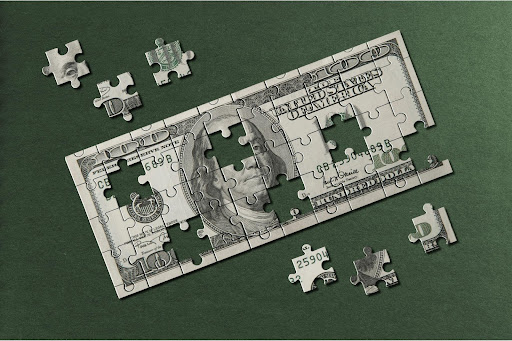Teaching your kids how to deal with money is a very delicate job. On the one hand, you should definitely try to introduce them to the world of finance early enough so that they can be ready to earn, spend, and save their own money when the time comes.
On the other hand, you don’t want to push them too hard and create emotionally detached money-making robots. Here, you want to strike the right balance by teaching them to be responsible, but not obsessed with money.
Obviously, you won’t be teaching your kids just how to manage money now, but you’ll be trying to instill habits and values that will stick with them until the rest of their lives. This job is very tricky and there are many potential obstacles and pitfalls, but it’s crucial to properly prepare your child for this upcoming chapter in their lives. As much as 54 percent of Americans live paycheck-to-paycheck, and often it simply comes down to bad money management.
If you’d like your kid to avoid being another one of those, education on money management is vital. Here are a few pieces of advice on how to best educate your children on this topic.

Start young and start with the basics
You can’t really start too early when it comes to teaching kids about money. Of course, you mustn’t overwhelm them with information and rules they’re still not even ready to understand.
At a very young age, you can’t really teach them to calculate compound interest, but they can easily learn some basic stuff through games that children play. Playing shop with them using play money is actually a great way to learn and understand elementary principles of how financial transactions work.
Use paper money as a first step
In general, paper money, whether it’s real or just for play, can be a very helpful tool for this purpose. Paper cash may be dying out in most of the western world, and your kids probably won’t use paper much, but it’s still the least abstract form of money. And as such, it should serve as a basis for any other knowledge related to finances.
Indeed, the very fact that they won’t be seeing many banknotes throughout their life means that you’ll have to explain how e-banking works, that “digital” money has real value, and that managing it badly has consequences. If they only see a bunch of numbers in the virtual space it can feel very elusive and unreal. In order to understand all the abstract concepts related to money, it’s crucial that they figure out how paper money functions first.
Prepare your kids for the world of digital finances
Of course, once they’re a bit older, you can teach them about more abstract and complex notions – how banks work, what taxes are, or what happens when you take a loan. It’s still important that you take things slowly and don’t press the child too much. If you see that they’re too overwhelmed, it may be too early for whatever you’re trying to explain and maybe you should leave it for later.
Once your kids become old enough and they’ve already learned a thing or two about money as well as developed at least some sense of financial discipline, you can teach them advanced stuff about how the system works and how to turn the system to their advantage. At this age, it’s very important that children have their own budget so they can plan and spend it the way they want, as it gives them a sense of freedom and independence.
Explain what it means to earn money
Most of the time, your kids will simply see you spend money. Most of the kids don’t ever see their parents work – they know you leave for work and come back in the evening, but they don’t really see that part of the process and how hard it is to make money.
And spending it is very easy. And fun. So you need to explain to your kids that money doesn’t just miraculously appear out of nowhere, that there’s no infinite supply of it, and that someone actually has to work hard for it. This means communicating with them about this, but also putting them into a situation where they can feel that themselves, on a smaller scale.

Allowance and chores
It’s perfectly fine to give your kids some kind of unconditional allowance that they’ll get whether they’ve worked for it or not. But you should definitely think about adding some money to that amount whenever the children do some chores around the house. This way they learn not only to handle their own money, but also that getting that money is never easy.
You can even create a system where every chore is worth a certain amount of money, and the children can choose how much they’ll work. It’s also an analogy for something that happens later in life all the time: if you don’t want to do something by yourself, it’s fine, but then you’ll have to pay someone else to do it.
Teach them that hard work pays off
Moreover, it doesn’t have to be just chores you’ll be rewarding. You can reward good grades, good behavior, or any kind of success your kid can achieve. It’s just crucial that the kids get a sense that you need to work for money, whichever sort of work that is.
Of course, later on, when they’re older, they can find a part-time job. For the first time in their life, they’ll have a bit more money than they used to, which is very exciting as they’ll get a chance to decide what to do with it. We’re not saying they’ll be investing their first salary in their pension fund, but if you got them to realize that you have to put a lot of effort in order to make money, it will definitely help them start shaping healthy financial habits in the long run.
Encourage your kids to save money
Saving as a life lesson
The lesson about saving is more than just a lesson about money. It’s an important life lesson about planning and being prepared. Your kids should learn soon enough that there will be many twists and turns in their lives and that nothing should be taken for granted. And that you can neutralize this constant threat only by having backup funds and planning ahead. In the world of money, that means saving.
So it’s vital to educate your kids about the importance of long-term planning, patience, and sacrifice. Then you can apply these values in money management. It might not be easy to do that, but you’ll have to communicate with your kids and try some useful tricks.
How to get your children to save?
For instance, it can help if you set some saving goals together with your child. Try showing that even a seemingly super-expensive thing can be bought if you display just a bit of persistence and self-control. The feeling of satisfaction that your kids will experience when they buy something with their own savings will most probably have a great effect on them and they’ll remember it forever.
Another great way to teach children how to save is to get them to track and even write down their spendings and income regularly. This not only teaches them discipline, but also always provides them with a clear overview of what’s going on with their finances at the moment. It’s perfect for them to acquire the habit of seeing the biggest possible picture when handling money.
Finally, offer your kids some extra rewards as well. A good way to encourage saving is by matching their savings or rewarding them when they reach some pre-determined milestones. Try associating some happy moments and feelings with saving money so that your kids can remember and internalize it as something truly pleasant.

Teach them how to spend
Your kids will learn how to save money not just by adopting a habit to stash it in the drawer and avoid spending it. It does help, but it’s also absolutely essential for them to master the art of spending. Spending is the flip side of your saving efforts and showing your children how to spend will tell them a lot about how to save.
First of all, avoid telling them directly what to buy and what not to buy with their money, especially as they get older. You can share your opinion, but don’t force them to agree with you. Let them follow their own needs and feelings and if they happen to make a mistake, it’s no big deal they’ve wasted $30 on something they won’t use or need.
It’s best that they realize this themselves, which should happen over time. Of course, you could help them understand why they can’t buy things they actually need – because they spent the money on stuff they don’t. But don’t make buying decisions for them, since once you stop doing that your kid certainly won’t have the faintest idea how to prioritize their expenditures. And then it might be too late already.
Also, introduce them to the concept of comparison shopping. Comparing multiple different options when you buy stuff is a very healthy habit that also helps reduce impulse buying and should be encouraged early on. Especially if they’re spending their own money.
Allow your children to make independent financial decisions
Moreover, your kids should learn how money works and how the economy works in general, when they’re a little older. They’ll need both theory and practice. You should take care of the theory and always try explaining stuff in terms they’ll understand, and you can also help them with practice.
You will get your kid to understand how everything works if you encourage independence as much as you can. We’ve already seen that you shouldn’t make buying decisions for them, but you can go a step further and let them create a shopping list with a pre-determined budget or even plan the family budget for a week. Of course, you can help them with that, but let them try to guide the process.
Only by being independent, they can develop instincts that will help them make smart financial decisions in the future. Independence will gradually change their habits, their worldview, and teach them to rely on themselves. Obviously, you’ll be by their side to help them learn everything they should and keep them out of trouble, but concrete choices should be made by the children, especially once they get older.

Get a BusyKid app
Modern technology has enabled a whole array of new parenting tools and methods. Chores and allowance apps can help your kids handle their finances and learn how to manage their money, but they can also help you monitor their activity and make sure they’re on the right track.
What is a BusyKid app?
BusyKid app offers many benefits like this to children and parents alike. For instance, you can set the price for any chore and the amount of allowance for each kid based on their age. Every child has their own account, their own balance, and even their own debit card that can be used in stores and ATMs.
The app tracks and stores all the transactions made by the kids, how they made the money, as well as when and where they spent it. It’s almost like a little bank statement with extra features.
How does BusyKid work?
Everything a child earns can be divided into three sections: save, spend, and donate. You can even add interest on the money your child is saving, and transferring the funds from the “save” section to “spend” is effortless.
BusyKid makes parents’ lives much easier. The allowance and rewards for doing chores are fixed and transparent, so there’s no room for anyone to feel unequally treated. Furthermore, kids today are generally very comfortable with this technology and they’ll have no trouble understanding how the app works.
Finally, BusyKid encourages independence as children can earn their own money and make their own buying decisions. Of course, they’re not totally independent as they need your approval for every transaction beforehand, just in case. This way, the kids are making their own choices but you still have control over everything if things happen to get out of hand.
For more info on the BusyKid app, visit our homepage: https://busykid.com/
Final thoughts
At the end of the day, probably the most important thing you can do to teach your kids money management is communicating. The concept of money is not as intuitive to kids as it is to adults and they need to get used to it before they can fully understand it. So make sure you’re open with them about money, and above all, be patient.
Also, all these tips won’t amount to anything if you’re not a proper role model. You need to demonstrate what you preach using yourself as an example. It’s the most effective way for children to learn how to deal with money and to adopt certain values and a certain attitude towards money. Make sure your kids truly have someone to look up to.












